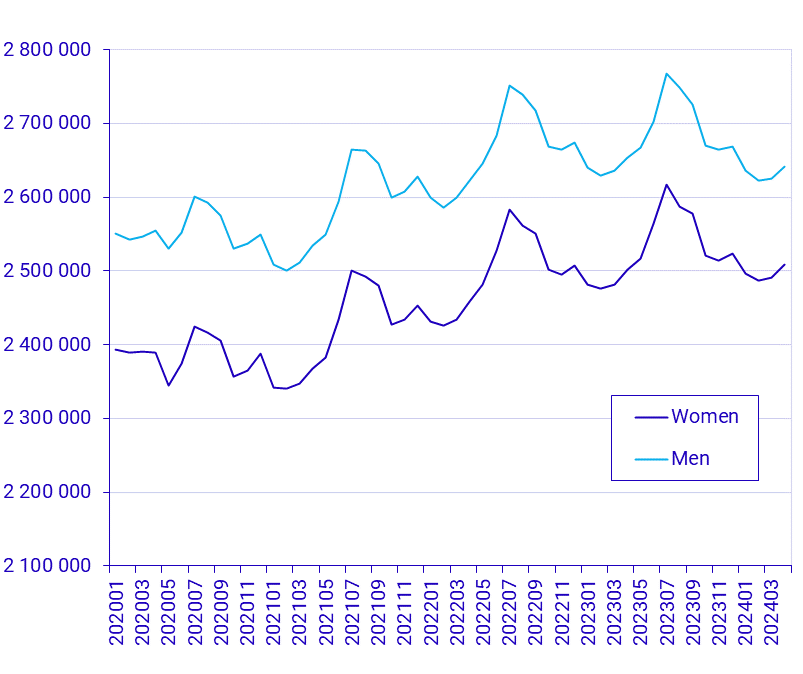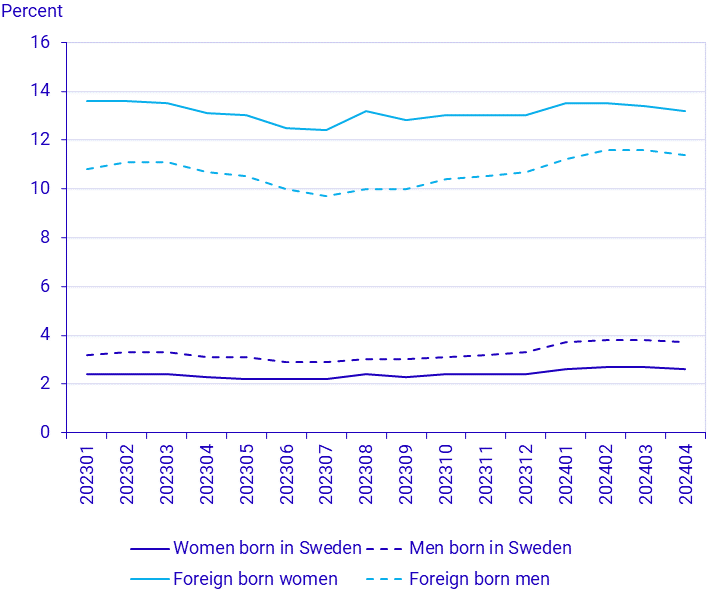Population by Labour market status, April 2024
Unemployment continued to increase in April 2024
Statistical news from Statistics Sweden 2024-06-27 8.00
People in employment aged 15 to 74 numbered 5 150 000 in April 2024. This is a decrease of 5 000 people compared with April 2023. In the 20 to 65 age range, 277 000 people were unemployed. This equals a share of 5.4 percent expressed as a percentage of the labour force and is an increase of 0.5 percentage point compared with the same period of the previous year.
People in employment
The number of people in employment aged 15 to 74 decreased in April 2024 by 5 000 compared with the same period of 2023, amounting to 5 150 000. Fewer women than men were employed. A total of 2 509 000 women and 2 641 000 men were employed.

In the 20 to 65 age range the employment rate – the number of employed people in relation to the population – was 79.1 percent in April 2024. The employment rate among women was 78.8 percent and 79.4 percent among men. Compared with April 2023, the employment rate was unchanged among women, while the employment rate among men decreased by 0.4 percentage points.
The unemployed
The number of unemployed people aged 20 to 65 in April 2024 was 277 000, which is an increase of 24 000 compared to the same period the previous year. A total of 129 000 women and 147 000 men were unemployed.
The relative unemployment rate - the proportion of unemployed people in relation to the labour force - was 5.2 percent for women and 5.6 percent for men. This equals an increased unemployment rate among woman of 0.3 percentage point, and 0.6 percentage point among men compared with the same period of 2023.
Unemployment is higher among foreign born people than among those born in Sweden. The relative unemployment rate was, among foreign born people, 13.2 percent for women and 11.4 percent for men. For people born in Sweden the relative unemployment rates was 2.6 percent for women and 3.7 percent for men in April 2024.

| April 2024 | March 2024 | April 2023 | Change since April 2023 (%) | |
|---|---|---|---|---|
| Employed | 5 150 000 | 5 116 000 | 5 155 000 | ‑0.1 |
| Men | 2 641 000 | 2 625 000 | 2 653 000 | ‑0.5 |
| Women | 2 509 000 | 2 491 000 | 2 502 000 | 0.3 |
| Men born in Sweden | 2 033 000 | 2 020 000 | 2 046 000 | ‑0.6 |
| Women born in Sweden | 1 957 000 | 1 944 000 | 1 961 000 | ‑0.2 |
| Foreign born men | 608 000 | 604 000 | 607 000 | 0.1 |
| Foreign born women | 552 000 | 548 000 | 541 000 | 2.0 |
| April 2024 | March 2024 | April 2023 | Change since April 2023 | |
|---|---|---|---|---|
| Employed | 4 802 000 | 4 783 000 | 4 809 000 | ‑0.2 |
| Men | 2 465 000 | 2 456 000 | 2 478 000 | ‑0.5 |
| Women | 2 336 000 | 2 327 000 | 2 331 000 | 0.2 |
| Employment rate (%) | 79.1 | 78.8 | 79.3 | ‑0.2 |
| Men | 79.4 | 79.1 | 79.9 | ‑0.4 |
| Women | 78.8 | 78.4 | 78.7 | 0.0 |
| Men born in Sweden | 82.8 | 82.5 | 83.3 | ‑0.5 |
| Women born in Sweden | 83.4 | 83.1 | 83.5 | ‑0.1 |
| Foreign born men | 70.1 | 69.7 | 70.5 | ‑0.3 |
| Foreign born women | 66.2 | 65.8 | 65.7 | 0.5 |
| Unemployment | 277 000 | 283 000 | 252 000 | 9.7 |
| Men | 147 000 | 151 000 | 132 000 | 12.0 |
| Women | 129 000 | 131 000 | 120 000 | 7.1 |
| Men born in Sweden | 72 000 | 75 000 | 62 000 | 17.5 |
| Women born in Sweden | 48 000 | 50 000 | 42 000 | 14.7 |
| Foreign born men | 75 000 | 76 000 | 70 000 | 7.2 |
| Foreign born women | 81 000 | 82 000 | 78 000 | 3.0 |
| Relative unemployment rate (%) | 5.4 | 5.6 | 5.0 | 0.5 |
| Men | 5.6 | 5.8 | 5.0 | 0.6 |
| Women | 5.2 | 5.3 | 4.9 | 0.3 |
| Men born in Sweden | 3.7 | 3.8 | 3.1 | 0.6 |
| Women born in Sweden | 2.6 | 2.7 | 2.3 | 0.3 |
| Foreign born men | 11.4 | 11.6 | 10.7 | 0.7 |
| Foreign born women | 13.2 | 13.4 | 13.1 | 0.1 |
| April 2024 | March 2024 | April 2023 | Change since April 2023 (%) | |
|---|---|---|---|---|
| Students | 195 000 | 197 000 | 188 000 | 3.8 |
| Men | 85 000 | 86 000 | 82 000 | 3.8 |
| Women | 110 000 | 111 000 | 106 000 | 3.7 |
| Retirees | 77 000 | 80 000 | 102 000 | ‑24.1 |
| Men | 39 000 | 40 000 | 50 000 | ‑22.6 |
| Women | 39 000 | 40 000 | 52 000 | ‑25.5 |
| Sick | 227 000 | 227 000 | 220 000 | 2.9 |
| Men | 101 000 | 102 000 | 99 000 | 3.0 |
| Women | 125 000 | 125 000 | 122 000 | 2.8 |
| Others | 493 000 | 503 000 | 491 000 | 0.3 |
| Men | 265 000 | 270 000 | 262 000 | 1.3 |
| Women | 228 000 | 232 000 | 230 000 | ‑0.8 |
Definitions and explanations
BAS, Population by Labour market status, presents statistics based on administrative data concerning aspects such as number of people in employment, unemployed people, and people outside the labour force for the registered population aged 15 to 74. The statistics can be used to describe current status, but also the progression over time. It illuminates both the entire population and smaller groups, such as detailed age groups at the municipal level.
The statistics contain estimates of the number of people broken down by labour market status: Employed, unemployed, student, retiree, sick and others. The definition of labour market status is hierarchical, which means that a person can only be assigned one labour market status, and it is determined according to the order of precedence above.
The labour force consists of employed people and the unemployed.
The labour market status categories that are outside the labour force are student, pensioner, sick and others. There are fewer people outside the labour force in the summer than during other parts of the year. This is mainly because some people who are students during term time work during the summer and are then classified as employed.
Feel free to use the facts from this statistical news but remember to state Source: Statistics Sweden.
